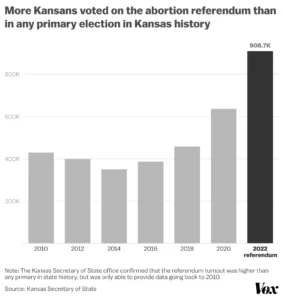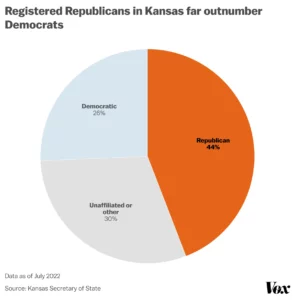So how might the Kansas choice-quake affect specific midterm races in November. Christopher Wilson shares some thoughts on the topic at Yahoo news: “Whether the fight over abortion can help Democrats retain control of Congress remains to be seen, but there are a number of high-profile races in swing states where the issue is already front and center. Among them:
- In Pennsylvania, Josh Shapiro, the Democratic nominee for governor, has been hammering his opponent, Doug Mastriano, over the Republican’s proposal for a full abortion ban in the state. Lt. Gov John Fetterman, the Democrats’ candidate for Senate, has made his desire to codify abortion protections part of his regular stump speech. Polls indicate Fetterman and Shapiro are both leading their Republican opponents.
- In Arizona, the Republican candidates for Senate and governor are both stridently opposed to abortion.
- In Michigan, Democratic hopes to retain the governor’s mansion could be buoyed by the likely presence of a ballot initiative protecting abortion rights. Democratic Gov. Gretchen Whitmer supports the measure.
- In Georgia, Democratic Sen. Raphael Warnock is attempting to hold onto his seat as his opponent, Herschel Walker, calls for a full ban on abortion with no exceptions. Recent polling has shown Warnock with a consistent but slim advantage over Walker.
At The Nation, John Nichols explains, “It’s Not Just Kansas—Voters Nationwide Are Pro-Choice,” and notes, “When reproductive rights issues are on the ballot, even in Republican-leaning states, well-organized and unapologetic pro-choice campaigns have established a winning record. That’s what happened in South Dakota in 2006, when voters rejected a sweeping abortion ban by a 55-45 vote, and where they did the same thing two years later—in a presidential election year—by roughly the same margin. That’s what happened in Mississippi in 2011, when voters opposed a so-called “personhood” amendment to the state Constitution, which sought to eliminate reproductive rights, by a 58-42 vote. That’s what happened in Florida in 2012, when, by a 55-45 margin, voters rejected a constitutional amendment that would have prohibited the state from spending public funds for abortions or health insurance that covers abortions. That’s what happened in North Dakota in 2014, when voters rejected a so-called “right-to-life amendment” by an overwhelming 64-36 margin….The Kansas victory on Tuesday resulted from grassroots boots-on-the-ground organizing and honest engagement on the issue. Television ads urged Kansas voters to reject a “strict government mandate” that “puts a mother’s life at risk” and that could “ban any abortion with no exceptions.” But this wasn’t just a media campaign. Pro-choice activists mounted an energetic grassroots organizing drive that reached out to a wide range of communities, including those in historically Republican rural counties—a number of which voted “no” on Tuesday. In some western Kansas counties, support for the pro-choice position on the ballot question ran more than 25 points better than the 2020 vote for Joe Biden….As the 2022 election season unfolds, activists in other states can learn a good deal from the Kansas activists who spoke bluntly about how banning abortion will take away fundamental rights, criminalize health choices, and prevent doctors and nurses from providing necessary care….if party activists make the case that abortion is on the ballot in November, if they boost turnout from pro-choice voters, and if Democratic candidates can achieve even a small measure of the swing seen in Kansas, the 2022 political calculus could be dramatically improved for Biden and for his party.” And, as the second chart in the post below indicates, Democratic campaigns would be wise to avoid bashing the Republican party in their door-to-door canvassing and abortion-related ads, and emphasize instead that only the Democratic candidate strongly opposes government meddling in women’s health care choices.
Rani Molla shares “4 charts that show just how big abortion won in Kansas” at Vox, including these two:


At The Hill, Shirin Ali reports that “After Kansas, four more states set to vote on future of abortion.” Ali writes that “four other states will pose similar measures to voters that address the future of abortion:
- California
The state on its Nov. 8 ballot will feature Proposition 1, which aims to amend California’s constitution to include the right to an abortion. The measure provides that the state cannot “deny or interfere with an individual’s reproductive freedom in their most intimate decisions,” including decisions to have an abortion or to choose or refuse contraceptives.
Gov. Gavin Newsom (D) has been doubling down on his efforts to make California an abortion sanctuary, including signing a law the shields California abortion providers and volunteers from lawsuits in other states. The state has also allotted more than $200 million in new spending to expand abortion in the state.
- Kentucky
Also on Nov. 8, voters in Kentucky will be able to vote on whether their state’s constitution should be amended to lay out that nothing in the state constitution creates a right to abortion or requires government funding of abortions.
Kentucky hopes to join four other states that currently have constitutional amendments declaring that their constitutions do not secure or protect a right to abortion or require the funding for the procedure.
The state has completely banned abortion, thanks to a trigger law that took effect quickly after the Supreme Court overturned Roe. The law makes limited exceptions like to prevent death or serious injury of the mother.
- Montana
Voters in Montana will get to weigh in on a state statute known as the Medical Care Requirements for Born-Alive Infants Measure on Nov. 8. It states that infants born alive at any stage of development should be considered legal persons; require medical care to be provided to infants born alive after an induced labor, C-section, attempted abortion or another method; and establish a $50,000 fine and/or 20 years in prison as the maximum penalty for violating the law.
Currently, abortion is legal in Montana up until 20 weeks of pregnancy and as long as the state constitution is not amended. Though the state has tried to enact several restrictive abortion laws, including one that would have stopped advanced practice registered nurses from being able to perform early abortion services. A judge blocked the law from taking effect.
- Vermont



